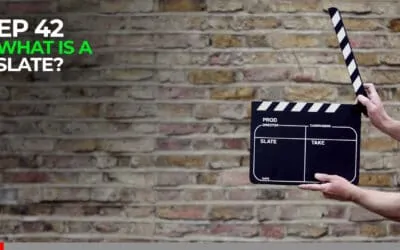What is a Slate?
Hello Everyone,
Its Josh here from Loveridge Digital, this week on “Getting into it with Loveridge Digital” we are going to cover what a slate is in video production.
The humble film slate, scuffed and scratched and tossed casually aside between setups, is actually a very important piece of equipment that no film set should ever be without.
Clapboard, clapperboard, film clapper, movie slate. They all mean the same thing if you’re searching for images of the universal symbol for “film production.” But on an actual film production, it is only ever called the slate — at least in the United States.
There are two parts to the film slate. The “slate” part is where we write all the identifying information about what is being recorded. Traditionally, this was made of actual slate, just like chalkboards.
The addition of hinged clapper sticks came about with sound, but these were originally clapped separately from the written slate.
Australian filmmaker F. W. Thring is credited for coming up with the idea of attaching the clapper to the top of the film slate. This was further perfected by pioneer sound master Leon M. Leon.
While you can still find wooden and chalkboard style slates being used, you’re more likely to see the acrylic “whiteboard” style on most sets. These are lighter and much more durable.
More importantly, they are a lot easier to see in just about any lighting environment because of the translucent nature of the plastic.
Professional filmmakers use video slates to make sense of what would otherwise be audio and visual mayhem. Directors often shoot scenes out of sequence and record audio separately from the visual portions of a production.
In addition to the information written on the slate, the clapper is brought down on the slate to create an audible “clap” sound for the audio recorder, When both the audio and video are brought into post-production, the editor can match the exact moment of both the “clap” and the closure of the clapper to sync both parts together with ease. The slate is used by the Second Assistant Camera Operator also known as Clapper or Loader
During modern times it has become rarer and rarer to see physical slates being used, Many producers have switched to digital slates instead.
Digital video slates and clappers include SMPTE time code display which allow for comprehensive-time readouts which allow for even greater accuracy during the synchronization process of the audio.
Thank you very much for taking the time to watch the video, I hope you found it informative and engaging, until next time.
Ready to Start a Project?
Get In TouchAcknowledgement to Country 2024
Loveridge Digital would like to acknowledge and pay respect to the traditional custodians of the Australian lands on which we work. We are honoured to be on the ancestral lands of those whose cultures are among the oldest living cultures in human history. We pay respect to the Elders, past, present and to the younger generation of the community who will be the future leaders in years to come.





